October 17, 2018
Reciprocating Compressor vs. Rotary Compressor
SHARE THIS POST
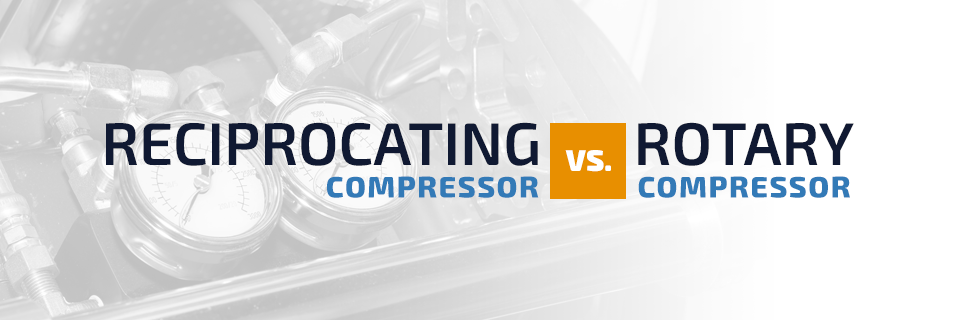
Compressed air is used across so many industries that it’s sometimes called “the fourth utility.” It is an essential part of many production processes, just like electricity or water. Air compressors come in all types and sizes. Two of the most popular kinds are reciprocating and rotary compressors.
Table of Contents
What Is the Difference Between a Reciprocating and Rotary Compressor
Rotary Screw Air Compressor vs Reciprocating
Reciprocating and rotary screw air compressors serve the same purpose and perform near identical functions. Both are designed to pressurize air for use in industrial applications, and both accomplish this task by sucking in atmospheric air, pressurizing that air in a cylinder and releasing that air for its end-point use. The main difference between the two compressor types comes down to the internal mechanisms used to achieve pressurization.
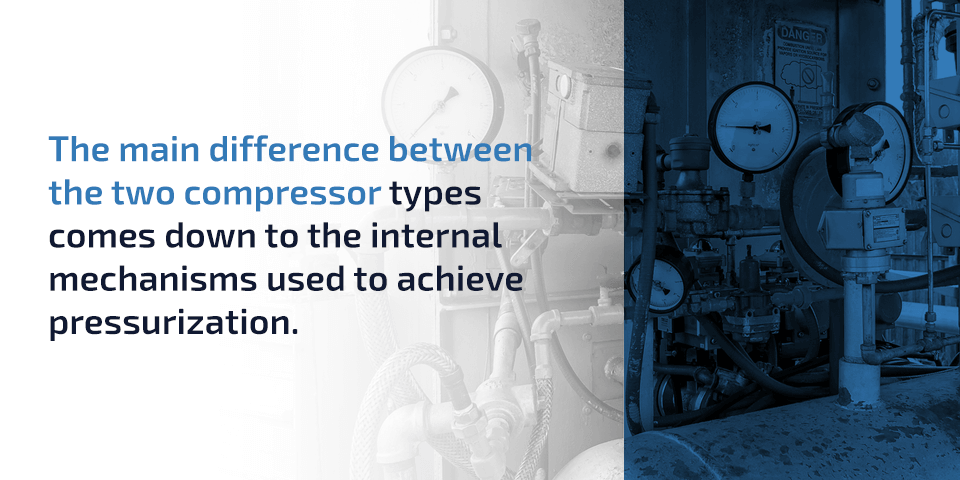
- Pistons
In a reciprocating air compressor, pistons draw air into the cylinder, pressurize that air and send it onward for its ultimate purpose. The process begins with a downward motion of the piston, where a vacuum is created that lowers the pressure in the cylinder and sucks an incoming supply of ambient air through the inlet valve. The piston then moves back up the cylinder and, in doing so, pressurizes the trapped air. The newly pressurized air is released to the next stage in the process, and the piston drops back down to suck in a new supply of air.
- Screws
In a rotary screw air compressor, two opposing screws turn in opposite directions within a cylinder as air passes from one end to the other. Due to the tightness of the space within the screw threads, the air quickly becomes pressurized through this process. Rotary screw compressors come in single-stage and two-stage models. In a single-stage compressor, the air is pressurized once. In a two-stage compressor, the newly compressed air is sent to a second, smaller chamber for further pressurization.
Uses of Air Compressors
Compressed air has been the driving force behind modern-day productivity levels in numerous industries. Rotary and sometimes reciprocating compressors are vital to the processes employed by food, furniture and vehicle manufacturers as well as wood and metal producers.
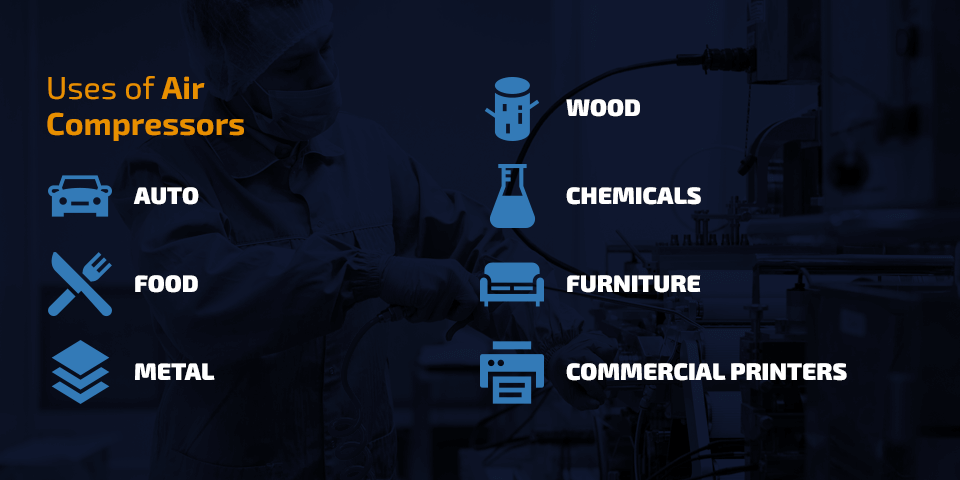
- Auto
Rotary screw air compressors have long driven production in the auto industry, where parts must be produced and assembled by the dozen on a minute-by-minute, ongoing basis throughout each day. At auto assembly plants, rotary compressors are used for the following functions:
- Precision-timed conveyor movement
- Air-powered mechanical arms
- Pneumatic spray painters
- Pneumatic parts fasteners
Thanks to the power of compressed air, parts are shifted along conveyor belts, assembled with pneumatic-powered arms, fastened with air-powered tools and ultimately sent along to the finishing stages, where pneumatic tools are used to clean, treat, paint and dry the assembled automobile.
- Food & Beverage
Oil-free air compressors play a crucial role in food production. At factories that turn out processed and packaged foods, canned goods and bottled beverages, air compressors drive the machinery that moves each item of food along from a state of raw ingredients to the sealed, finished product. The production of applesauce, for example, requires air-powered machinery at the blending, mixing, pouring, sealing and labeling stages.
Pneumatic robot arms and machinery are also crucial to the mass production of bottled drinks. Compressed air cleans bottles and moves them in timed precision along a conveyor, where overhead pneumatic tools fill each passing bottle in measured amounts. From there, each bottle is sealed and labeled with air-powered machinery. Reciprocating compressors allow beverage manufacturers to drive productions in mass quantities that would be impossible with manual labor and far more costly with electrical tools and machinery.
Without the efficiency, speed, timing and capabilities afforded by air compressors and pneumatic tools, food manufacturers would be incapable of producing packaged foods at the volumes needed to meet the demands of today’s hungry consumers.
- Metal
Rotary compressors have been a boon to metal production. With air-powered tools and machinery, metal manufactures can produce shapes and cuts from a range of alloys with utmost speed, ease and precision. Rotary compressors make it possible to drive the processes of heavy-duty metal cutting and sculpting machinery across factory floors with minimal human involvement. This keeps workers out of harm’s way and allows manufacturers to produce metal products in high volumes that would be difficult, if not impossible, to generate with hand-operated tools.
- Wood
Rotary compressors have driven the production of wood materials and products for decades. With an arsenal of rotary compressors, wood factories can convert raw lumber into precisely cut and measures boards. Different types of air-powered tools are employed on various woods for the mass production of wooden knobs, cabinet doors, table legs, desk parts and numerous other everyday furnishings and fixtures. Rotary compressors drive everything from mechanical arms that can lift weights beyond human strength to the cutting tools that carve wood products into shape at speeds that exceed human capabilities.
- Chemicals
Air-powered tools and machinery play a vital role in the mixing, handling, testing and packaging of chemicals, many of which are dangerous to touch. With rotary air compressors, chemical manufacturers can formulate and generate chemicals for industrial and commercial product use while keeping factory personnel out of harm’s way when it comes to the mixing and handling of chemicals that are toxic or dangerous. Moreover, factories use pneumatic tools and machines to apply chemicals to finished parts and products intended for industrial and commercial use.
- Furniture
Rotary compressors play an integral role in the production of household furniture and fixtures, from the preparation of legs and panels to the assembly of chairs and tables. At furniture factories, air-powered machine arms lift heavy panels onto conveyor belts where pneumatic tools fasten parts together. Stage-by-stage, furnishings come together thanks to the cutting, sanding, fastening and finishing capabilities of air-powered tools and machinery. From wooden desks and tables to upholstered sofas and loveseats, the various furnishings that you see every day are assembled in factories that heavily rely on rotary compressors.
- Commercial Printers
Rotary compressors are commonplace at printing plants where inks are distributed across passing rolls of paper. From the printing of newsprint to the production of product labels, air-powered machines are behind most of the things you read and see on the shelves. For magazines and newspapers, air compressors make it possible to produce installments in vast quantities for mass distribution. Without the power and precision of pneumatic machinery, such tasks would consume far more energy.
Advantages of Air Compressors
For a vast range of industrial applications, air compressors provide numerous benefits over manual labor and electrical power. Overall, air compressors allow for safer, more efficient, more productive and less hazardous operations.
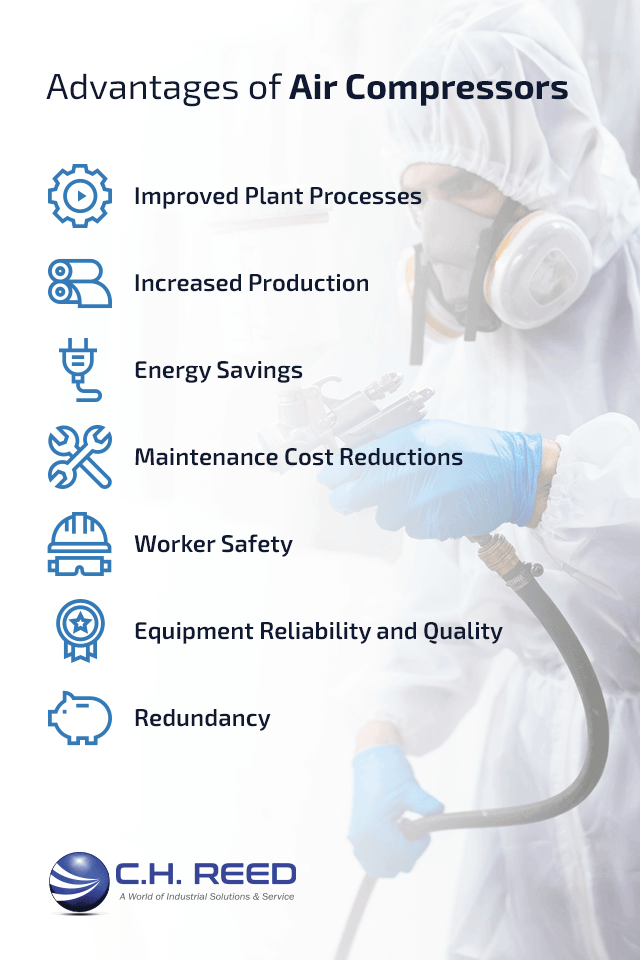 Improved Plant Processes
Improved Plant Processes
At plants across the industrial sector, rotary compressors make processes easier, faster, more eco-friendly and more efficient. In the auto industry, for example, the capabilities of air-powered tools allow automakers to drastically reduce their use of machines that run on fossil fuels and that require more labor-intensive human exertion. Air-powered tools also allow for cleaner processes and better sanitation at food manufacturing plants, where the use of pneumatic arms and machinery necessitates fewer human bodies on the floor as raw foods are packaged.
Increased Production
The speed and efficiency generated by air-powered tools have left earlier means of production in the dust. When factories employ machines and tools that run on rotary compressors, the speed and precision of the productions at hand vastly outpace competing productions that rely solely on old-fashioned machinery and human labor. Air-powered tools can be programmed at specific speeds to complete processes to exact precision, whether this involves the filling of bottles to particular ounces or the cutting of woods and metals to precise measurements.
Maintenance Cost Reductions
With rotary air compressors, factories face fewer maintenance issues throughout a given year. The costs associated with periodic maintenance are also lower with rotary compressors because the steps involved are usually limited to oil changes and filter replacements. As such, maintaining a rotary compressor is generally easy and predictable. With machines that run on electricity, more problems could arise throughout a year due to issues with complex mechanisms and circuitry.
Worker Safety
Rotary compressors make productions far safer for factory personnel. At plants, air-powered robotic arms and tools handle the more dangerous processes. This allows workers to avoid exposure to toxic chemicals and noxious gases that could be harmful to skin, eyes, lungs and other organs. Air compressors also drive the machines that handle heavy-lifting tasks, thereby relieving workers of the more physically exerting aspects of factory work. With air compressors on hand to perform the dangerous and heavy functions, workers avoid potentially disease-causing exposure and physical injuries.
Equipment Reliability and Quality
Air-powered tools and machines are capable of executing processes with utmost precision and accuracy. Regardless of the steps involved, the tools that are driven by rotary compressors run according to computerized durations and measurements. When bottles are filled along an assembly, the pouring equipment is programmed to pour the liquids in question at specified ounces. In chemical production plants, formulas are mixed to exact specifications and done so without the potential for error that would be inevitable if left to human hands.
Redundancy
Rotary screw air compressors provide a low-cost, low-maintenance option for system redundancy at factories and pressing plants. As rotary compressors are designed to run non-stop, you can employ one or two compressors to run regular operations and have one or two additional compressors on standby for backup purposes. This way, if one compressor goes down, one of the standby compressors can be activated as a backup source of air-power. Therefore, you never have to worry about system downtime, which would otherwise be time-consuming and costly if you rely on conventional machinery.
Air Compressor Maintenance
As far as maintenance is concerned, rotary compressors have the clear-cut advantage over reciprocating compressors. Whereas rotary compressors are relatively simple in terms of design, reciprocating compressors consist of complex valves and piston rings that need maintenance on a more frequent basis where daily, weekly, monthly, quarterly, and bi-annual maintenance checks must be performed.
On a rotary compressor, simple and periodic maintenance, like oil changes, is the most cost-effective way to lengthen the life of your compressor. On a seasonal basis, the oil filter and oil/air separator should be inspected for dirt deposits and changed out if necessary. After about a decade of use (give or take), you will need to replace the air end. Otherwise, the maintenance and repairs associated with the rotary compressor are generally pretty straight forward. However, with many components being exposed to various environmental and operating conditions, rotary screw compressors of all types and sizes should be check and serviced regularly. Today’s rotary compressors are equipped with electro-pneumatic or microprocessor controllers. The purpose of this function is to facilitate non-stop loads with regulated airflow at all load levels, from fully loaded to unloaded.
To get the most life out of your compressed air system, regardless of its size or type, we advise customers to set up a planned maintenance program.
Which Compressor Type Is Better?

Reciprocating air compressors are typically meant for intermittent use when smaller, non-continuous amounts of compressed air is needed. They are best optimized when used in smaller applications; approximately 25 HP or less. Reciprocating air compressors come in lubricated and non-lubricated varieties. In the former, oil is released into the cylinder. The purpose here is to ease the strain on the cylinder and piston rings. The reason for non-lubricated air compressors is that certain applications —such as in the food or pharmaceutical industries — must remain free of even the slightest trace of oil at all times. There are also oil-free rotary screw options as well. Oil-free rotary compressors opt for non-contacting carbon ring seals that aid their cooling. These seals prevent any chance that oil may enter the air stream inside the compressor. Centrifugal compressors also offer a steady stream of oil-free air.
Due to the up-and-down movement of the piston, reciprocating air compressors produce more noise than rotary compressors, which are simply equipped with opposing turning “screws”. By the nature of its design, the rotary compressor generates less vibration. As previously stated, reciprocating compressors are also designed to work in increments, whereas rotary compressors are built to run continuously. Some other benefits of rotary compressors are high mechanical energy transfers, adaptability to different working conditions, their quite operation and mobility, and advanced, flexible control options.
Ultimately, the choice between a rotary or reciprocating air compressor should be based on how often you intend to use the compressor and to what extent. If you intend to use the compressor less than a third of the time, a reciprocating compressor might be better since the pistons are not designed to run nonstop throughout a day. If you intend to run the compressor continuously, a rotary compressor would be the best option because the two meshing helical screws, also known as rotors, are made to run continuously.
Air Compressors and Maintenance from C.H. Reed, Inc.
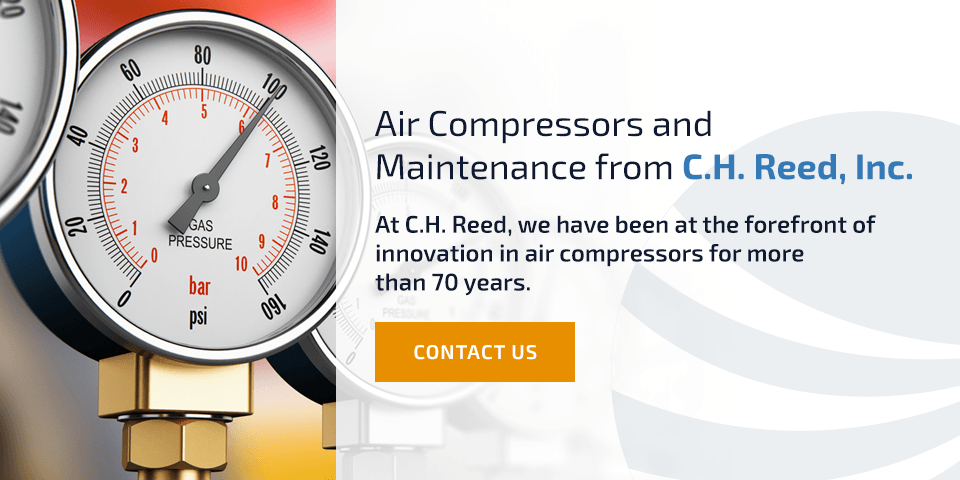
There are a lot of other factors that go into choosing the right compressor for your application. To see which type of air compressor might best suit you, explore the C.H. Reed catalog and contact us today to speak with a compressor specialist. At C.H. Reed, we have been at the forefront of innovation in air compressors for more than 70 years. We also perform service and maintenance on a wide variety of compressed air systems and equipment. Contact us today for more information.
Search
Categories
Get a consultation
Related Posts
The 3 Distinct Advantages of Hydraulic Powered Pumps
Recently, C. H. Reed helped a major printing operation install a new ink pumping system. The new system needed to transfer four colors of high viscosity, heat-set ink to their three presses, drawing the ink from multiple 5,000…
Simple Ways to Reduce Waste in Your Spray Finishing System
In today’s demanding manufacturing landscape, it can be convenient to adopt a “cut-costs-at-all-costs” mentality, justifying questionable means for the sake of leaner production, a lower bottom line and increased profitability. Regrettably, those efforts can interfere…
What You Need to Know About Air-Powered Pressure Washers
Pressure washers are great solutions for your average cleaning applications, but what tool do you turn to for your more challenging applications? There are many instances where it is simply impossible to use a traditional…